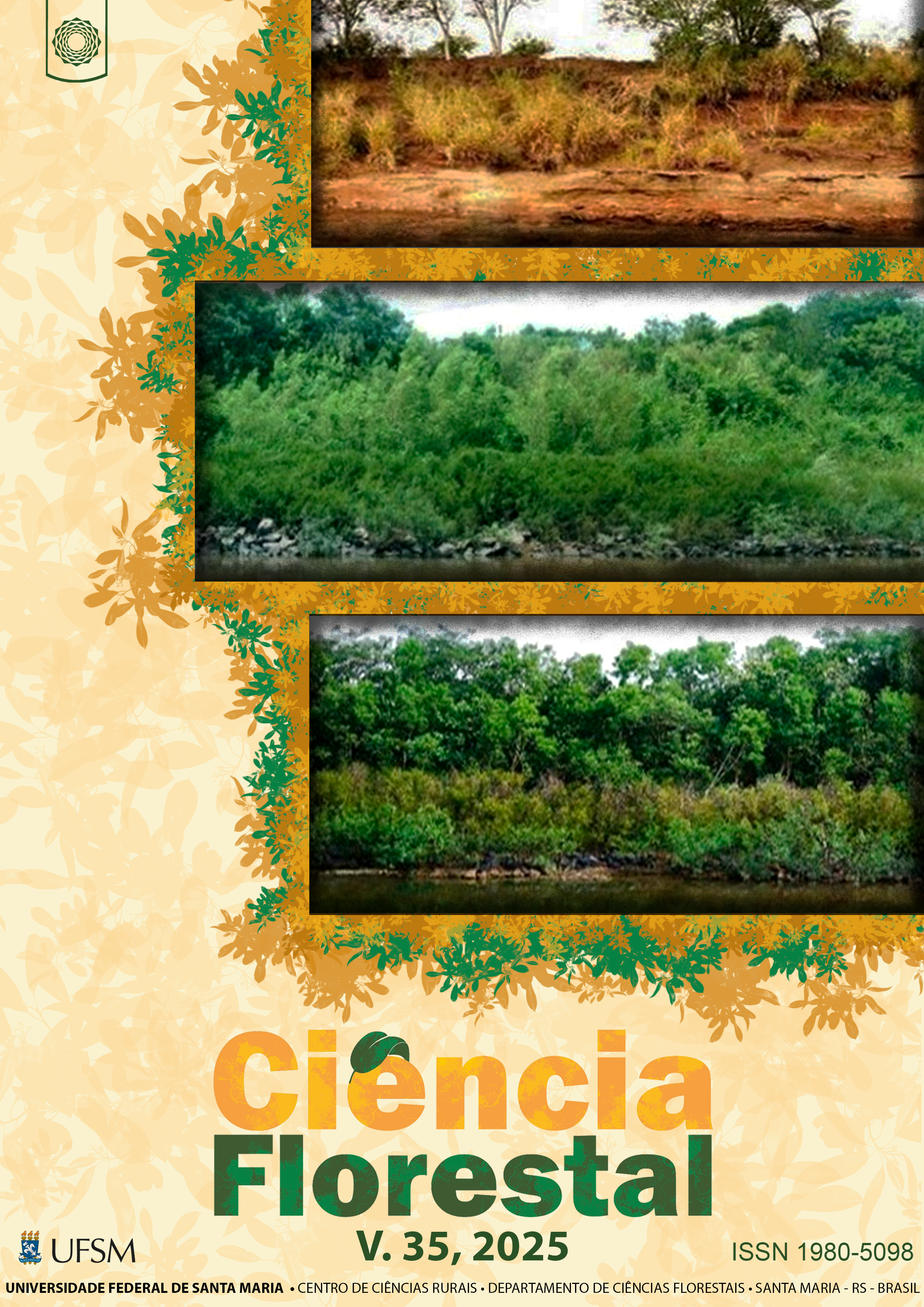Genetic selection of <i>Handroantus serratifolius</i> (Vahl) S. O. Grose in the Federal District - DF
DOI:
https://doi.org/10.5902/1980509871795Keywords:
Vigor test, Electrical conductivity, Progeny selection, Genetic improvementAbstract
Electrical conductivity is a quick and excellent method for assessing seed viability. With this in mind, the aim of this study was to select Handroantus serratifolius progenies for seed carriers in the Federal District, Brazil. The seeds were processed to remove the wings, after which they were soaked in distilled water for 0, 30 and 60 minutes to be evaluated using an electrical conductivity meter. Genotypic variability was observed among the progenies evaluated, so electrical conductivity can be used to select the matrices that provided the progenies. The ratio of the genotypic coefficient of variation to the experimental coefficient of variation was greater than unity, indicating that the genetic gains should be of high magnitude. Matrices 7 and 8 proved to be the best of all. The electrical conductivity method should be used to assist in genetic programs for Ipê-amarelo.The results obtained were significant, so there is a need to split them to better understand the effect of the variable studied. Electrical conductivity proved to be a good variable for selecting genetic gains and selecting progenies so that a genetic improvement program could be implemented. The CVg/CVe values for all evaluations were greater than 1, proving to be a favorable factor for the breeding program. Matrices 7 and 8 proved to be the best of all. The electrical conductivity method should be used to help with Ipê-amarelo genetic programs.
Downloads
References
ADÁMOLI, J.; MACEDO, J.; AZEVEDO, L. G.; NETTO, J. M. 1987. Caracterização da região dos Cerrados. In: GOEDERT, W. J. (Ed.). Solos dos Cerrados: tecnologias e estratégias de manejo. Planaltina: EMBRAPA - CPAC; São Paulo: NOBEL, p.33-98.
ANGELI, P. H. M. S. A. Implantação e manejo de florestas comerciais. Documentos florestais IPEF, Piracicaba, n.18, 2006. 16 p.
BITTENCOURT JÚNIOR, N.S. Auto-incompatibilidade de ação tardia e outros sistemas reprodutivos em Bignoniaceae. 275f. Tese (Doutorado em Biologia Vegetal). Universidade de Campinas. 2003.
BORLAUG, N. E. Feeding a World of 10 Billion People: The Miracle Ahead. In Vitro Cellular & Developmental Biology. Plant, v. 38, n. 8, 2002.
BRASIL. Regras para análise de sementes. 2009.
DALANHOL, S.J.; REZENDE, E.H.; ABREU, D.C.A.; NOGUEIRA, A.C. Teste de condutividade elétrica em sementes de Bowdichia virgilioides Kunth. Revista Floresta e Ambiente, v. 21, n. 1, p. 69-77, 2014.
FALEIRO, F. G.; RAGAGNIN, V. A.; CRUZ, C. D.; BROMMONSCHENKEL, S. H.; MOREIRA, M.A.; BARROS, E. G. Selection of common bean lines based on yield, grain type growth habit and disease resistance. Crop Breeding and Applied Biotechnology, v. 2, p. 507-514, 2002.
FERREIRA, R. L. Teste de condutividade elétrica para estimar o vigor de sementes de urucum. Multi-Science Journal, v. 1, n. 3, p. 3-10, 2015.
GERBER, D.; BRUN, E. J.; TOPANOTTI, L. R.; FERREIRA, J. J.; PORRUA, D. A.; GORENSTEIN, M. R.; WAGNER JÚNIOR, A. Variabilidade genética do crescimento inicial de Araucaria angustifolia Bertol.: subsídio para formação de pomares de sementes. Ciência Florestal, Santa Maria, v. 31, n. 1, p. 310-332, jan./mar. 2021.
GOULART L.M.L.; PAIVA H.N.; LEITE H.G.; XAVIER A.; DUARTE M.L. Produção de Mudas de Ipê-amarelo (Tabebuia serratifolia) em Resposta a Fertilização Nitrogenada. Floresta e Ambiente, v. 24, e00137315, 2017.
HAMPTON, J.M.; TEKRONY, D.M. Handbook of vigour test methods. Zürich: ISTA, 117p, 1995.
HIGA, A. R.; SILVA, L. D. Pomar de sementes de espécies florestais nativas. Curitiba: Fundação de Pesquisas Florestais do Paraná, 266p, 2006.
LAVIOLA, B. G. et al. Desempenho agronômico e ganho genético pela seleção de pinhão‑manso em três regiões do Brasil. Pesq. agropec. bras., Brasília, v. 49, n. 5, p. 356-363, maio 2014.
NETO, J. T. F. et al. Estimativas de parâmetros genéticos e ganho de seleção para produção de frutos em progênies de polinização aberta de pupunheira no Estado do Pará, Brasil. Bragantia, Campinas, v. 72, n. 2, p.122-126, 2013.
POTT, A.; POTT, V.J. Plantas do Pantanal. Corumbá: EM-BRAPA/CPAP – SPI, 320p. 1994.
RIBEIRO-OLIVEIRA, J. P.; RANAL, M. A. Sementes florestais brasileiras: início precário, presente inebriante e o futuro, promissor? Ciência Florestal, Santa Maria, v. 24, n. 3, p. 771-784, jul.-set., 2014.
ROSA, S. D. V. F.; PINHO, E. V. R. V.; VIEIRA, M. G. G. C.; VEIGA, R. D. Eficácia do teste de condutividade elétrica para uso em estudos de danos de secagem em sementes de milho. Revista Brasileira de Sementes, v. 22, n. 9, 2000.
ROSÁRIO, W. C.; RODRIGUES, A. A. C.; OLIVEIRA, A. C. S.; MAIA, C. B.; MARQUES, B. R. Fisiologia, sanidade e controle de fitopatógenos em sementes florestais da Reserva Extrativista Quilombo do Frechal em Mirinzal – MA. Ciência Florestal, Santa Maria, v. 32, n. 2, p. 959-978, abr./jun. 2022.
SANTOS, S. R. D. O. S. E; PAULA, R. C. D. E. TESTE DE CONDUTIVIDADE ELÉTRICA PARA AVALIAÇÃO DA QUALIDADE FISIOLÓGICA. 27, 136–145, 2005.
SOARES, I. D.; HIGA, A. R.; FLORES JUNIOR, P. C.; ENGEL, M. L.; ANDREJOW, G. P. Estratégias de seleção de progênies de Eucalyptus saligna para produção de sementes melhoradas. Sci. For., Piracicaba, v. 45, n. 114, p. 319-326, jun. 2017.
VIEIRA R.D.; KRZYZANOWSKI F.C. Teste de Condutividade Elétrica. In: Krzyzanowski FC, Vieira RD, França JB No. Vigor de Sementes: Conceitos e Testes. Londrina: ABRATES; p. 4-26, 1999.
Downloads
Published
How to Cite
Issue
Section
License
Copyright (c) 2024 Ciência Florestal

This work is licensed under a Creative Commons Attribution 4.0 International License.
A revista CIÊNCIA FLORESTAL reserva-se o direito de realizar, nos originais, alterações de ordens normativas, ortográficas e gramaticais, com vistas a manter o padrão escolar da língua, mas respeitando o estilo dos autores. As provas finais podem ou não ser enviadas aos autores.






